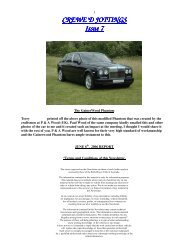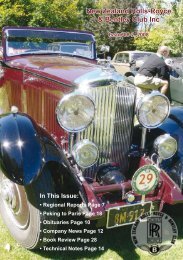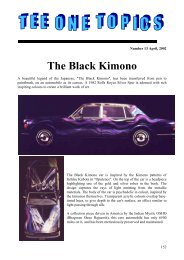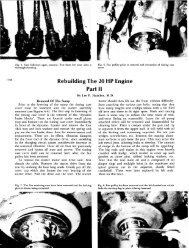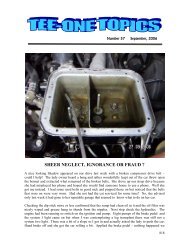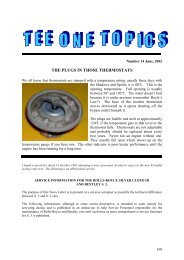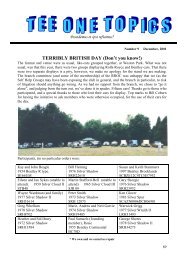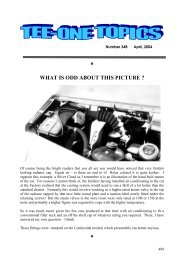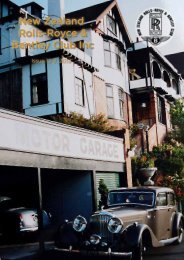New Zealand Rolls-Royce & Bentley Club Inc - The Enthusiasts ...
New Zealand Rolls-Royce & Bentley Club Inc - The Enthusiasts ...
New Zealand Rolls-Royce & Bentley Club Inc - The Enthusiasts ...
Create successful ePaper yourself
Turn your PDF publications into a flip-book with our unique Google optimized e-Paper software.
Lucas Wiper Motors by Eddie Riddle<br />
Lucas wiper motors of the cable driven type are really very reliable.<br />
Having said that the early versions are susceptible to voltage loss<br />
in the brush gear. <strong>The</strong> solution to this problem is to solder a piece<br />
of very flexible wire (one strand off a starter brush works fine)<br />
to the back face of the brush holder and the other end to the wire<br />
that forms the connection to the system. Repeat this for the other<br />
brush. It is essential that you don’t let solder run down the flexible<br />
cable. Check that the brush holders are still free to move.<br />
<strong>The</strong> first of the cable-operated wipers had wheelboxes<br />
with a ¼”shafts to which the wiper blade is connected. <strong>The</strong> system<br />
is that the inner cable of the drive connects to the gearbox on the<br />
wiper motor and the other end passes through the wheelboxes.<br />
As the gearbox rotates the inner cable is pulled backwards and<br />
forwards thus operating the wiper arms.<br />
If the vehicle has wipers where the blades move in<br />
opposite directions (referred to as “clap-hands” operation) it is<br />
necessary to mount one of the wheelboxes upside down. By this I<br />
mean if the cable enters the wheelbox at the top then the other one<br />
must enter at the bottom.<br />
<strong>The</strong> control of the wiper motor is via a switch on the<br />
dashboard, which in turn is fed from the ignition switch.<br />
<strong>The</strong>se wipers are satisfactory on windscreens, which are<br />
was reversed during parking. <strong>The</strong> main advantage was that the<br />
wiper arms were now parked completely off the windscreen. This<br />
model was only used on the expensive English cars.<br />
<strong>The</strong> control of the motor is in the earth circuit not the live side.<br />
<strong>The</strong> three wires to the motor are:<br />
• Pin 1 to A4 (live feed)<br />
• Pin 2 to earth via the dashboard switch<br />
• Pin 3 is the earth connection<br />
<strong>The</strong> system was particularly fussy about a smooth curve<br />
with no sharp bends in the first section of the outer casing, from<br />
the motor to the wheel box. This often led to motors burning out.<br />
<strong>The</strong> outer casing is 3/8” Bundy tubing. After flaring the ends it is<br />
a simple matter to gently bend the tubing. It is easiest to bend the<br />
tubing over a large diameter former like a tyre, which is inflated<br />
hard. With the wiper blades removed you should be able to move<br />
the inner cable freely in and out of the casing.<br />
An improvement in performance can be made in reducing<br />
the voltage loss in the brushes by the same method as detailed<br />
earlier.<br />
<strong>The</strong> end float in the armature is important here as<br />
excessive clearance can lead to the wiper motor failing to switch<br />
off.<br />
George Urquhart’s newly painted 1933 20/25 Freestone & Webb Limousine GSY12. Philip Eilenberg’s photograph<br />
flat, but they really struggle on the later curved type windscreens.<br />
This system was replaced in the mid 1950s by the DR series of<br />
wiper motors.<br />
<strong>The</strong> DR series had the following improvements:<br />
• Wiper box spindles are now 0.5” diameter splined shafts<br />
• Automatic parking when the wipers are turned off<br />
• Heavier inner cable<br />
• More powerful motor<br />
<strong>The</strong> DR3 models were 2 speed versions of the DR2<br />
DR4 was a series with a complex parking system where the motor<br />
A check of the wiper blade pressure on the screen is<br />
important. It needs to be just enough to keep the blade in contact<br />
with the screen. Excessive pressure leads to burning out armatures<br />
when operated on a nearly dry screen.<br />
<strong>The</strong> motor is designed to move slightly on the three rubber<br />
mounting bushes. If it is found that the three rubber mounting<br />
bushes are damaged, then the most likely cause is excessive wiper<br />
blade pressure.<br />
14



